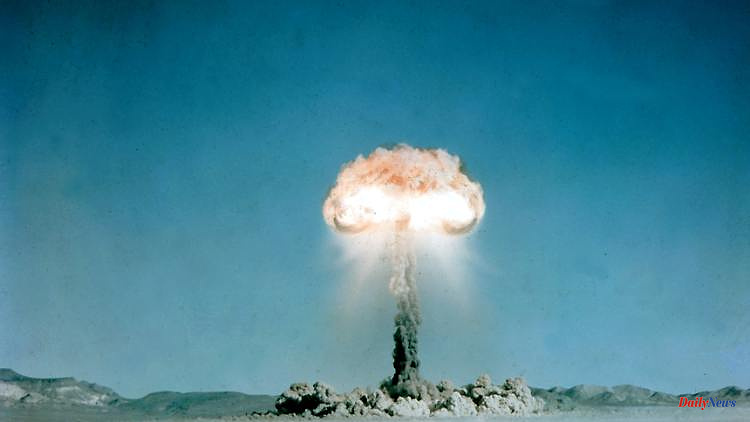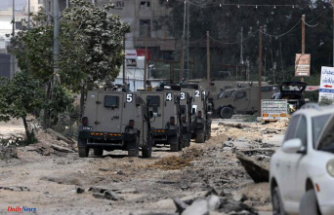Mankind still has to live with the danger of a nuclear apocalypse. But can't you protect yourself from atomic bombs? ntv.de has peace researcher Jürgen Altmann explain everything about existing defense systems, new technical approaches and science fiction concepts.
With the war of aggression against Ukraine, the feeling of a nuclear threat, which has largely disappeared since the late 1980s, has returned. The nuclear apocalypse is once again being talked about in public and in private. From Germany's point of view, the situation is clear: If we are threatened by some of the approximately 13,000 nuclear weapons worldwide, then it is those in Russia.
There, one's own atomic abilities have been emphasized again and again, especially recently. An excerpt from a Russian talk show became known, in which there was talk of a nuclear attack on Germany within 106 seconds - with the "Sarmat" missile, the world's largest intercontinental ballistic missile.
In principle, there are various ways of bringing a nuclear weapon to its target: long-range bombers, cruise missiles, short- and medium-range missiles, as well as ICBMs launched from submarines or from land. The latter in particular are difficult to defend against. The reason: they are incredibly fast, about 20 times faster than sound. "So fast that it's difficult to do anything about it," says physicist and peace researcher Jürgen Altmann in an interview with ntv.de.
Nevertheless, there are missiles that can even intercept ICBMs. In the USA, the Ground-Based Midcourse Defense (GMD) is stationed with 44 interceptor missiles. Israel owns the "Arrow 3", which has already been successfully tested, and the purchase of which has already been considered in Germany. Russia and China, for their part, have anti-missile missiles in service.
They are all intended to hit enemy ICBMs in the middle flight phase, i.e. still in space. But because of the high speeds, extreme haste is required. "If you know where they're going, you might have five or ten minutes to calculate the trajectory and see which of the existing missile defense systems is close enough to the approach path to hit them," says Altmann.
The approaching warheads are to be rammed with so-called kill vehicles. It's like hitting a bullet with a bullet. And success is uncertain. Only a few tests of Western defense missiles are known, recently some were successful, but before that often not. A study sponsored by the American Physical Society recently concluded that the US defense system could not withstand even a limited nuclear strike.
It would also be easy to equip ICBMs with decoys to confuse enemy defenses, says Altmann. "You could blow up lots of little balloons in space that have the same cone shape as the nuclear warheads." Because of the lack of air resistance, these balloons would fly just as fast as the actual warhead. A cloud of perhaps 100 objects would form that could not be distinguished from one another from a distance.
And that's not all: Russia and China have already put into service a new type of nuclear weapon: hypersonic missiles. These no longer fly far into space, but glide in the thin atmosphere at an altitude of 20 to 30 kilometers to their destination. "They can also do hooks and fly arcs with small rudders. That makes it completely impossible to predict where they will arrive," says Altmann. Only in the last one or two minutes do you know where they will hit. That's hardly enough to defend against.
Today's defense systems therefore offer no protection against a nuclear strike by a powerful major power such as Russia. "There's no chance of being in a position to shoot down everything that approaches," says Altmann. "And just one warhead that gets through could destroy a major city and cause untold damage." However, there are considerations of hitting ICBMs earlier when they are more vulnerable, i.e. shortly after launch.
While ICBMs are fast, they are significantly slower within a short window of time after launch. The heat from the rocket engine also makes them easier to locate. They are therefore particularly vulnerable in this starting phase. However, this is only about three to five minutes long - so hurry is also required here.
The idea of using powerful lasers to shoot down aircraft from nuclear missiles in the launch phase has already been pursued in the USA. The principle is called "Early Intercept". A suitably equipped Boeing was successfully tested for the first time in 2010. However, the program was mothballed for cost reasons. "The system was based on a chemical laser," says Altmann. A starting rocket is irradiated for tens of seconds. The problem: "The tank is empty after 40 laser uses."
In addition, the range of flying laser weapons is limited to a few hundred kilometers. However, since they can only fly along the borders of an enemy state, they are completely useless in the case of Russia, for example. "Russia is too big and most of the missile bases are too far inland, a few thousand kilometers from the border," says Altmann. The USA therefore sees flying anti-nuclear bomb lasers more as protection against smaller countries such as North Korea or the potential nuclear power Iran. The concept is to be pursued further. In the future, however, with unmanned drones and an electric laser.
In the 1980s there was already the idea of using space lasers to build a gigantic shield against Russian nuclear missiles. In 1983, the Strategic Defense Initiative (SDI) was presented by then US President Ronald Reagan. A whole range of different high-tech weapons should be tested to test the possibility of a protective shield against incoming nuclear missiles. One of the ideas was space-based laser weapons that heat up warheads and render them harmless.
But that's not so easy: "The warheads are small objects that have a protective layer on their shell like on the underside of a space shuttle. This protects them from the heat when they re-enter the atmosphere," says Altmann. Large amounts of energy are therefore required to burn through this thermal protection with a laser. In addition, "20, 50 or 100" laser-armed satellites are needed so that one is always close enough to effectively switch off approaching warheads.
It's technically feasible, says Altmann, but it's an incredibly big effort - and incredibly expensive. A study from 1987 already came to the conclusion that the US space weapons concept can hardly be implemented. "Nothing has really changed in this basic situation," says Altmann. And even if one had the astronomical means for it: Even such advanced defense weapons offer "no chance of achieving a defense rate of 80 or 90 percent".
However, recent advances have been made in computer technology. Couldn't you simply paralyze the opponent's nuclear arsenal with a hacker attack? The idea sounds both tempting and plausible: In the event of an acute threat, the enemy's nuclear arsenal is simply hacked and put out of action. "Until now, there was practically no possibility of hacking because the nuclear weapons systems still worked with the first computer technologies of the 1970s and 80s," says Altmann. But recently, the switch to an internet connection and the latest computer electronics has begun. The systems are now "theoretically somewhat more open to attacks via the network".
All nuclear powers are of course aware of this danger, says Altmann. "You will probably make high-intensity efforts to prevent that. And probably also try to attack your own systems with red teams." Red teams are groups that act like an opponent in order to detect security gaps in computer systems.
"Each of the three major nuclear powers would like to be able to at least read the communications of the others. But they would prefer to be able to switch off the systems right away to prevent a nuclear attack on their own side," says Altmann. However, it is unclear whether this possibility exists. "If you're trying to achieve computer security anywhere, it's certainly in the nuclear weapons systems."
What are the alternatives? Japanese researchers led by particle physicist Hirotaka Sugawara presented a futuristic concept in 2003: With a strong beam of very light elementary parts, so-called neutrinos, warheads should be switched off where they are stored, no matter where on earth they are.
Because of their low mass, neutrinos can traverse hundreds, even many thousands of kilometers of rock unhindered. The neutrino beam is to be directed through the Earth's interior to its target, such as a nuclear warhead in a bunker. The neutrinos trigger a shower of particles in the rock, which hits the warhead and renders it harmless, if not even causes it to explode. The possession of nuclear weapons would thus become a security risk for every actor.
"It doesn't sound completely implausible," says physicist Altmann about the draft. "First of all, it's just a thought experiment." The Japanese researchers themselves acknowledged some weaknesses in their concept. A particle accelerator with a circumference of 1000 kilometers would be required to generate the neutrinos, which is "completely insane", as they write. The plant would also probably cost more than 100 billion dollars and require an output of 50 gigawatts, about a quarter of the power plant capacity currently installed in Germany. "That's completely unrealistic for the next few decades," says Altmann.
As long as there are nuclear weapons, there will also be efforts to protect against them, says Altmann. But he warns of a dangerous mechanism: As soon as the protective effect of a certain technology increases, the other side follows suit in order to maintain their nuclear capabilities. This has already been shown by the development of hypersonic weapons by Russia and China in response to US missile defenses. "The pursuit of defensive options creates the pressure for an arms race and crisis instability," says Altmann.
In the end, only global cooperation on arms limitation might be the solution. "One could agree to limit the number of nuclear weapons held by the major nuclear powers to 100 each. And then to set up an inspectorate to monitor that," says Altmann. From the perspective of the peace researcher, there are already developments that give rise to hope. The - now suspended - INF treaty of 1987 to abolish short- and medium-range weapons or the New START treaty between the USA and Russia, which was extended in 2021, to reduce strategic nuclear weapons are examples of this. You can build on that.
So is there hope? "It's a question of political will and political insight," says Altmann. Over time, the realization could prevail that military means cannot guarantee absolute security. Then maybe a form will be found to organize security internationally - in the end maybe even without nuclear weapons.












